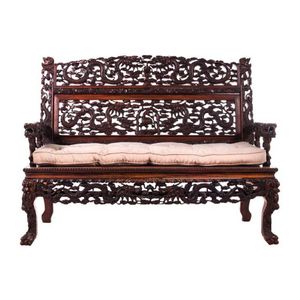Victorian Walnut Canterbury with Pierced Fretwork Walls
You must be a subscriber, and be logged in to view price and dealer details.
Subscribe Now to view actual auction price for this item
When you subscribe, you have the option of setting the currency in which to display prices to $Au, $US, $NZ or Stg.
- Inlay - Decorative patterns inserted into the main body of a piece of furniture, generally in wood of contrasting colour and grain, though brass, ivory, ebony, shell and sometimes horn have been used. Inlay may consist of a panel of well figured timber inset into a cabinet door front, geometric patterns, or complex and stylized designs of flowers, swags of foliage, fruits and other motifs. As a general rule, in pieces where the carcase is constructed in the solid, the inlay is relatively simple such as stringing, cross banding and herringbone banding. Where more elaborate and decorative work was required veneer was used. Inlay has been fashionable from at least the latter half of the 17th century, when a variety of elaborate forms were developed
- Fretwork - Pierced intricate decorative patterns, cut with a fine saw and generally found around the galleries of desk tops, open-hanging shelves and small tables.
In open fret, the timber is completely pierced, giving an appearance of great lightness and delicacy.
With blind fret, as seen in Chinoiserie styles of Chippendale, the fretwork is applied like a moulding to a solid panel. - Victorian Period - The Victorian period of furniture and decorative arts design covers the reign of Queen Victoria from 1837 to 1901. There was not one dominant style of furniture in the Victorian period. Designers used and modified many historical styles such as Gothic, Tudor, Elizabethan, English Rococo, Neoclassical and others, although use of some styles, such as English Rococo and Gothic tended to dominate the furniture manufacture of the period.
The Victorian period was preceded by the Regency and William IV periods, and followed by the Edwardian period, named for Edward VII (1841 ? 1910) who was King of the United Kingdom and the British Dominions and Emperor of India for the brief period from 1901 until his death in 1910. - Pierced Decoration - Ornamental woodwork with part of the background cut through and removed to produce an open-work pattern.
- Turned Legs - are legs which have been turned on a lathe. In use from the 16th century, turned legs on tables, chairs and cabinets became more frequent until, by the 1830s, the Georgian square or tapered leg was rarely found except in country pieces.
- Turning - Any part of a piece of furniture that has been turned and shaped with chisels on a lathe. Turned sections include legs, columns, feet, finials, pedestals, stretchers, spindles etc. There have been many varieties and fashions over the centuries: baluster, melon, barley-sugar, bobbin, cotton-reel, rope-twist, and so on. Split turning implies a turned section that has been cut in half lengthwise and applied to a cabinet front as a false decorative support.
This item has been included into following indexes:
Visually similar items

A Victorian pierced and inlaid burr walnut canterbury fitted with a drawer. Width 56 cm.

Victorian mahogany canterbury, 19th century, having three slatted partitions with carved shell and sea scrolls, above a single drawer, on castors, height 49 cm

An early 20th century heavily carved Burmese credenza featuring a large mirrored back, four drawers and two doors to base, elevated on cabriole legs, four barley twist columns, 190 x 185 x 50 cm

A Chinese export ware settee & matching armchair late Qing Dynasty (1644-1912), late 19th century, each heavily carved and pierced with dragon & cloud motifs, flanked by dragon head armrests
